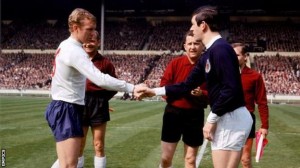Do ‘friendly’ international football matches have any value? Of course they have different values to different parties; administrators may view the visit of a high profile nation as an important revenue stream. To managers, they are an opportunity to get squads together, to try out players and systems, a notch up from a squad session but ten down from an actual competitive encounter. To the players and the fans, the context matters. For a young player to be included in their first squad, it is the realisation of dream, no matter who the opposition are. By the time they have accumulated ten or so caps, the gloss of the friendly has worn off. In a season of 50 plus games it is often difficult not to see it as one that doesn’t matter much. Fan behaviour is easily quantified – bums on seats. Friendly’s that matter have to mean something. Coming so close after a bitter and divisive Referendum campaign the Scotland vs England ‘friendly’ means a great deal – to the Scots.
Psychologically the two teams are in very different places approaching the encounter. The only real success for the England team in the recent World Cup came off the field. For the first time since 1966, the public relations around the FA successfully managed expectations. In every interview and press release, the message was clear – this is a young, inexperienced team, building for the future, expect little. Little was expected and little was delivered. That little was delivered is in large measure due to the systemic problems in the top tier of football in England; problems which most people at the heart of the game south of the border recognise but are unwilling or unable to resolve. Despite the hype, the Premiership is fit for only one purpose; the continued prosperity of the Premiership. It will never, in its current form support the development of a consistently successful England team. The manager knows this and so do the players.
Scotland approach the upcoming game in a very different frame of mind. The appointment of Gordon Strachan as manager in 2013 was a bold move. There were fears that Strachan’s close connections to Celtic would render him unacceptable to the other half of Glasgow. This proved not to be the case as performances and results improved. Most recently Scotland have stretched the World Cup winners in Germany, losing narrowly, drawn against Poland and beaten Georgia. The team are level on points in the European qualification table with Germany. As we all know, football is a results business, but even in this environment, there is little equivocation. Scotland are playing excellent football. The players appear to be responding to their manager in a way which Roy Hodgson, his England counterpart must envy.
So what part does the international manager play in the performance of a team at this level? The answer is complex and is nuanced by the questions – who is the manager and what is the team. I’m not a ‘fly on the wall’ but I suspect that Strachan’s influence on his players is greater the Hodgson’s influence is on his. What is my rationale for this assertion? The most basic ingredient in the development of a successful team, whether in football or in selling computers is communication. Effective communication is grounded in three factors, trust, honesty and respect. Both managers are articulate and intelligent; both have commendable but not outstanding records in management. In fact Hodgson’s is probably more impressive. What Strachan has over Hodgson is the insight into the player’s mindset which comes not just from having lived and breathed it, but also thought deeply about how the manager’s behaviour impacts on the players in their squad. England have tried to go down the same route in the past, appointing Glen Hoddle and Kevin Keegan to the top job. Both had success, but ultimately failed because one of the three basic ingredients was compromised. Hodgson, shares more with Sir Alf Ramsey than Hoddle or Keegan. But whilst Ramsey had Moore, Charlton and Hurst as genuinely World Class players to work with, the premiership doesn’t produce players like that anymore, or if it does, they have first been developed in Spain, Germany or Italy and are not English.
And so back to Celtic Park on the 18th November; the latest chapter in the Scotland vs England saga. Scotland will relish the opportunity to make a comment, the players and management will say all the right things in the lead up to the game – there is no place for politics in football. No-one will believe them as ‘God Save the Queen’ is booed by 60,000 fans. England will play tentatively, their premiership stars will be harried and pressured and commentators will speak of their collective lack of confidence. Scotland will fail to convert their chances and somehow England will steal a win…and international ‘friendlies’ have no value at all…unless you or your team win.
This ‘sows ear’ of a blog entry was transformed into a silk purse by editor Steven Vass and appeared on “The Conversation” website – Thanks Steven – much appreciated.

 Is there incontravertable evidence?
Is there incontravertable evidence?
